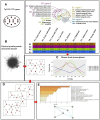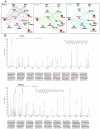Spatiotemporal 7q11.23 protein network analysis implicates the role of DNA repair pathway during human brain development
- PMID: 33859276
- PMCID: PMC8050238
- DOI: 10.1038/s41598-021-87632-x
Spatiotemporal 7q11.23 protein network analysis implicates the role of DNA repair pathway during human brain development
Abstract
Recurrent deletions and duplications of chromosome 7q11.23 copy number variants (CNVs) are associated with several psychiatric disorders. Although phenotypic abnormalities have been observed in patients, causal genes responsible for CNV-associated diagnoses and traits are still poorly understood. Furthermore, the targeted human brain regions, developmental stages, protein networks, and signaling pathways, influenced by this CNV remain unclear. Previous works showed GTF2I involved in Williams-Beuren syndrome, but pathways affected by GTF2I are indistinct. We first constructed dynamic spatiotemporal networks of 7q11.23 genes by combining data from the brain developmental transcriptome with physical interactions of 7q11.23 proteins. Topological changes were observed in protein-protein interaction (PPI) networks throughout different stages of brain development. Early and late fetal periods of development in the cortex, striatum, hippocampus, and amygdale were observed as the vital periods and regions for 7q11.23 CNV proteins. CNV proteins and their partners are significantly enriched in DNA repair pathway. As a driver gene, GTF2I interacted with PRKDC and BRCA1 to involve in DNA repair pathway. The physical interaction between GTF2I with PRKDC was confirmed experimentally by the liquid chromatography-tandem mass spectrometry (LC-MS/MS). We identified that early and late fetal periods are crucial for 7q11.23 genes to affect brain development. Our results implicate that 7q11.23 CNV genes converge on the DNA repair pathway to contribute to the pathogenesis of psychiatric diseases.
Conflict of interest statement
The authors declare no competing interests.
Figures






Similar articles
-
Spatiotemporal 16p11.2 protein network implicates cortical late mid-fetal brain development and KCTD13-Cul3-RhoA pathway in psychiatric diseases.Neuron. 2015 Feb 18;85(4):742-54. doi: 10.1016/j.neuron.2015.01.010. Neuron. 2015. PMID: 25695269 Free PMC article.
-
Spatiotemporal 22q11.21 Protein Network Implicates DGCR8-Dependent MicroRNA Biogenesis as a Risk for Late-Fetal Cortical Development in Psychiatric Diseases.Life (Basel). 2021 May 31;11(6):514. doi: 10.3390/life11060514. Life (Basel). 2021. PMID: 34073122 Free PMC article.
-
Reciprocal duplication of the Williams-Beuren syndrome deletion on chromosome 7q11.23 is associated with schizophrenia.Biol Psychiatry. 2014 Mar 1;75(5):371-7. doi: 10.1016/j.biopsych.2013.05.040. Epub 2013 Jul 17. Biol Psychiatry. 2014. PMID: 23871472 Free PMC article.
-
7q11.23 deletion and duplication.Curr Opin Genet Dev. 2021 Jun;68:41-48. doi: 10.1016/j.gde.2021.01.013. Epub 2021 Feb 17. Curr Opin Genet Dev. 2021. PMID: 33610060 Review.
-
Copy number variation at 22q11.2: from rare variants to common mechanisms of developmental neuropsychiatric disorders.Mol Psychiatry. 2013 Nov;18(11):1153-65. doi: 10.1038/mp.2013.92. Epub 2013 Aug 6. Mol Psychiatry. 2013. PMID: 23917946 Free PMC article. Review.
Cited by
-
Dorsal visual stream and LIMK1: hemideletion, haplotype, and enduring effects in children with Williams syndrome.J Neurodev Disord. 2023 Aug 26;15(1):29. doi: 10.1186/s11689-023-09493-x. J Neurodev Disord. 2023. PMID: 37633900 Free PMC article.
-
Contribution of Congenital Heart Disorders Associated With Copy Number Variants in Mediating Risk for Brain Developmental Disorders: Evidence From 20-Year Retrospective Cohort Study.Front Cardiovasc Med. 2021 Jul 15;8:655463. doi: 10.3389/fcvm.2021.655463. eCollection 2021. Front Cardiovasc Med. 2021. PMID: 34336942 Free PMC article.
-
Prenatal diagnosis, ultrasound findings and pregnancy outcome of 7q11.23 deletion and duplication syndromes: what are the fetal features?BMC Pregnancy Childbirth. 2024 Nov 6;24(1):727. doi: 10.1186/s12884-024-06920-2. BMC Pregnancy Childbirth. 2024. PMID: 39506689 Free PMC article.
References
Publication types
MeSH terms
Substances
LinkOut - more resources
Full Text Sources
Other Literature Sources
Research Materials
Miscellaneous

